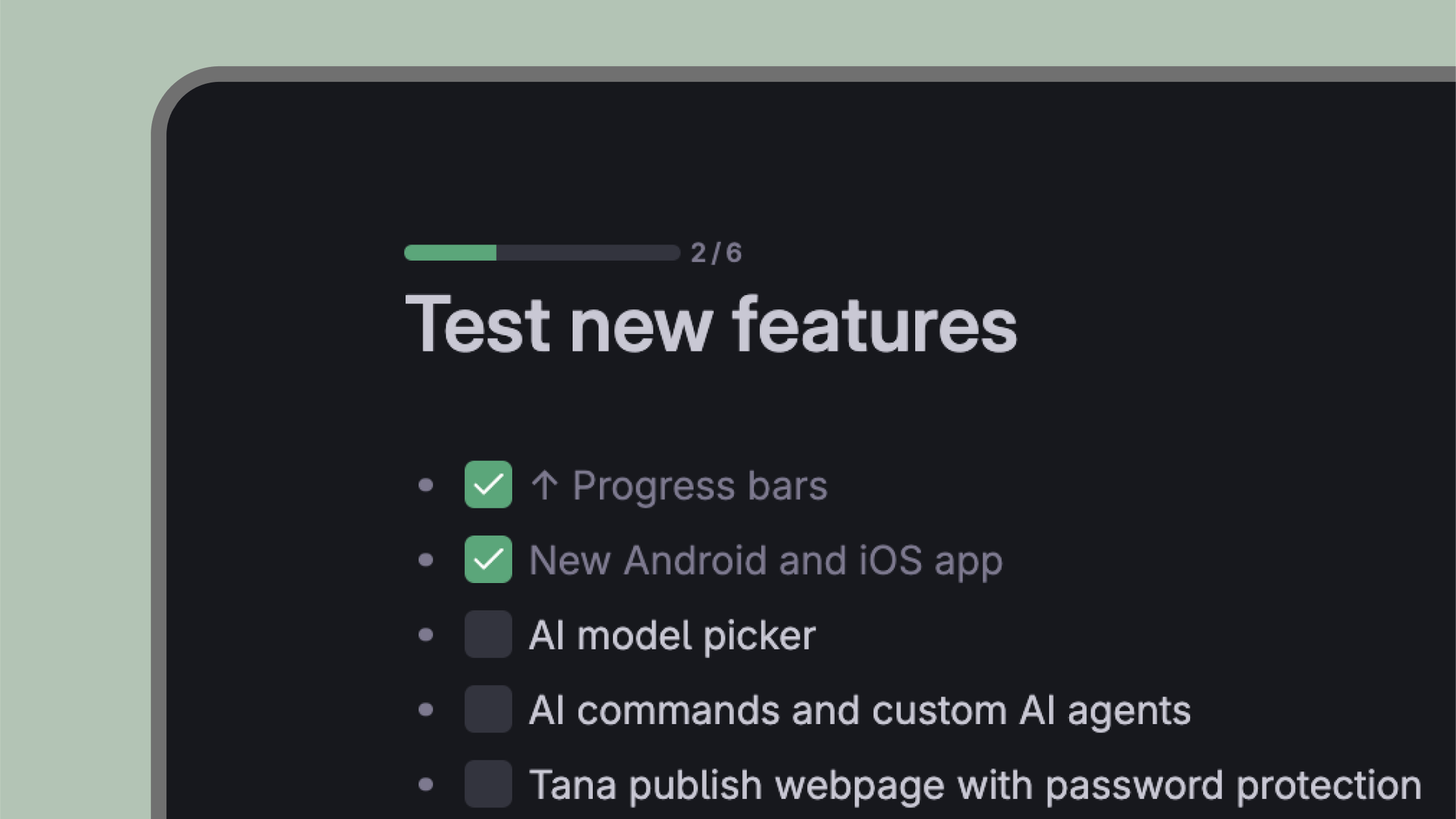Track progress at a glance with sidebar progress bars
It’s a lightweight feature with a big impact: whether you’re managing multiple projects, planning your week across meetings, or building a second-brain system, progress bars make it easier to stay oriented and act on what matters next.
How task management works in Tana
Tana handles tasks in a unique way compared to traditional apps. Instead of creating a special “task database” or rigid table, any node can instantly become a task.
You simply hit Ctrl or Cmd + Enter to turn a node into a checkbox. Toggling a checkbox updates the node’s system fields (Done and Done time), which gives you clean, structured data without any setup.
Because Tana is an outliner with a knowledge graph underneath, tasks naturally stack into larger structures. When you add checkboxes under a node, the parent node above automatically becomes a progress bar, showing how many of its subtasks are complete. No configuration. No formulas. No database schema. You just outline your work and Tana turns it into structure.
This system is what enables the new sidebar indicators.
Smarter progress bars that reflect real work
Progress bars in Tana aren’t static counts. They reflect the structure of your work in real time.
Here’s how they work:
• Any node with checkbox children gets a progress bar, showing a completion ratio.
• Progress rolls up through the hierarchy. A project with sub-projects will show a single, accurate progress bar for the entire tree.
• Nested bars always contribute upward. If a task list sits several levels deep, its state still affects your top-level project.
• Search results are included. If a search node returns items containing checkboxes, those also contribute to the progress. This makes dynamic lists feel alive.
• Everything updates the moment you check something off.
This design allows Tana to express progress the same way you think about work: nested, contextual, interconnected.
Now visible in your sidebar
With the new update, any node with a progress bar can be dragged into your sidebar. Tana will show a circular indicator next to it, updating instantly as subtasks are completed.
Hover over the indicator to see a breakdown of completed items, or expand the node in place to work through your outline without losing your place.
You can also pin search nodes to the sidebar. Because Tana counts progress inside search results, you get an always-up-to-date indicator for things like:
• tasks due this week
• meetings missing summaries
• content pieces still in draft
• action items assigned to you
• tasks created in the last 24 hours
This makes the sidebar a powerful command center, especially if your work spans many projects and meetings.
Why this matters for people choosing a productivity app
Most productivity tools force you to choose between two extremes:
• list-based task apps that separate tasks from context
• database tools that require upfront structure, templates, or formulas
Tana takes a different approach: structure emerges from the outline you’re already writing.
This means:
• You can take notes freely during meetings and mark tasks inline.
• Tasks automatically roll up into progress bars without extra setup.
• You can organize later without losing context.
• You can build powerful dashboards simply by pinning nodes or searches.
For managers juggling multiple projects and back-to-back meetings, this creates a workflow that stays fast while still giving you clarity across everything you're responsible for.
Try it out
- Turn any node into a checkbox with Ctrl or Cmd + Enter.
- Add subtasks under a project node.
- Watch the parent turn into a progress bar automatically.
- Drag that node into the sidebar to see a real-time progress indicator.
- Pin any saved search to track dynamic sets of tasks as they appear.
This system grows with you: start with a simple outline, and the structure becomes richer as your notes, tasks, and projects evolve.
Task management that reflects how you think
Tana’s progress bars aren’t just another UI convenience. They’re a natural extension of the outliner and knowledge graph underneath the workspace. They help you see progress where it really exists: inside your notes, inside your projects, and across all the dynamically generated lists that shape your work.
For anyone comparing productivity apps or researching tools for structured note taking, task tracking, or networked thinking, this feature shows what makes Tana different. You capture your work in the moment, and Tana turns it into meaningful structure you can rely on.

